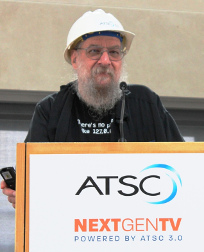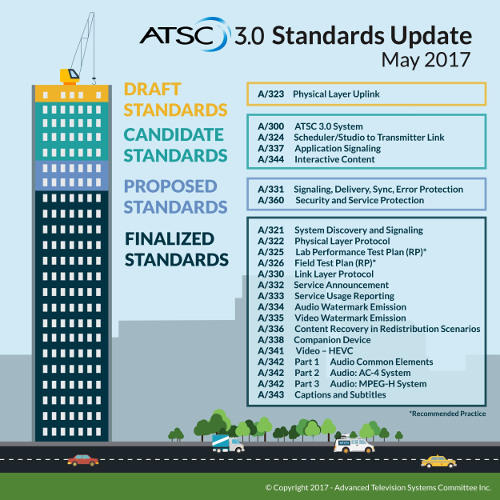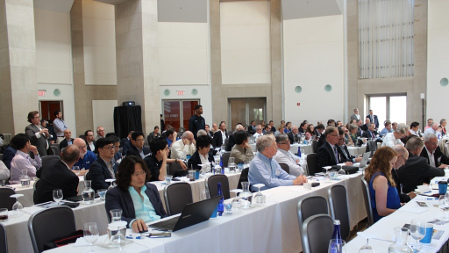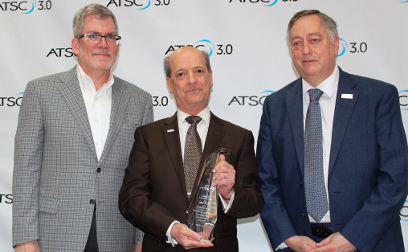ATSC Examines 3.0 Progress, Views Future

Richard ChernockWASHINGTON—“The goal is in sight!” might well sum up the feelings of standards group members and others who convened at the Ronald Reagan Building and International Trade Center to review and celebrate their work during the ATSC’s May 16-17 “Next Gen TV” conference.
Madeleine Noland, chair and vice chair of several ATSC 3.0 standards groups, perhaps best captured the spirit by proclaiming in her first-day welcoming address that“the standard is neigh-on finished.”
The ATSC 3.0 “Skyscraper” model depicts the amount of progress made in developing the new standard.

Click on the Image to Enlarge
Richard Chernock, chair of the standard’s TG3 technology group, on day two of the conference further reinforced the fact that the standard is nearing completion with a special “Finishing the ATSC 3.0 Skyscraper: General Contractor’s Report,” in which he described the project in terms of the construction of a 23-story high-rise structure, with each building level corresponding to one module of the standard. As illustrated in the drawing Chernock used in his presentation, 15 of the standard’s elements are now considered “finalized.” Three others have been elevated to the “proposed standards” level, and four have achieved “candidate” status, leaving only a single component—the A/323 Physical Layer Uplink/Downlink—in “draft” form.
(As it stands now, the standard is sufficiently complete to allow Korean broadcasters to launch ATSC 3.0 service at the end of May.)
MOBILE: TELEVISION’S NEW FUTURE
A common theme at the conference centered around the rising consumption of video content on small screen mobile devices. Brian Markwalter, senior vice president, research and standards for the Consumer Technology Association, reported that studies commissioned by his organization showed a significant increase during the past year in ownership of viewing devices other than conventional television sets by U.S. households. Another study flagged a significant rise between 2012 and 2016 in the viewing of video content on such devices as smart phones, laptops and tablets, while also showing a falloff in the viewing of content on conventional television receivers during the same period. In another presentation (“Checklist for ATSC 3.0 Implementation”), GatesAir’s Rich Redmond stressed the importance of transmitting a vertical signal component in order to reach mobile devices.
Mark Aitken, vice president of advanced technology for Sinclair Broadcast Group, also acknowledged the growing use of handheld devices for consuming video, stating that his company believes this is where television’s future lies.
The professional video industry's #1 source for news, trends and product and tech information. Sign up below.

Mark Aitken (Photo Credit: ATSC)
“We see ATSC 3.0 as a bridge to what we have consistently pointed to as a ‘mobile first’ opportunity for broadcasting,” he said. “It’s the mobile side [of the standard] that we see the most potential in, and it’s the mobile side that we are going to explore intensely.
“We look at mobile and think of ourselves as being the new mobile wireless carriers. Mobile, we believe, will become the economic enabler for massive investment in television. We’re underscoring dozens of reasons that we see mobile as the true opportunity. Our vision of a ‘mobile first’ future is in taking advantage of this once in a lifetime opportunity with a repack and major recapitalization in the industry to move in this direction.”
Aitken observed, however, that a problem now exists in obtaining satisfactory ATSC 3.0 receiver performance in mobile environments, as the integrated circuits being used in these receivers were really designed for fixed receiver applications.

More than 200 persons packed the Ronald Regan Building’s Pavilion room for the 2017 ASTSC annual meeting.
“This is the reason that Sinclair is investing millions of dollars into the development of its own ATSC chip set,” said Aitken. “And that chip set is being built and designed fundamentally from the ground up as a ‘mobile first’ chip set.”
In response to a question from the audience, Aitken stated that to get the ball rolling on the mobile 3.0 front, Sinclair was willing to supply the chips being developed for this purpose to manufacturers who would agree to use them in their mobile products.
“We will put millions of chips into the hands of suitable device manufacturers free of cost,” he said.
THE TRANSITION TO IP
While the main focus of the conference was the ATSC 3.0 standard itself, the program also included discussions and presentations addressing the movement from SDI-based television plant infrastructures to all-IP environments. The conference also discussed methodologies broadcasters might employ in rolling out high dynamic range and expanded color gamut technologies, production of content for such HDR and ECG broadcasts.
Attendees also focused on the FCC’s stance on advanced television implementation, the value of low-power television operations in connection with the 3.0 transition, an update on the joint NAB/CTA Cleveland, Ohio field testing facility, single-frequency networks, virtual reality, 5G’s potential and the U.S. television broadcast spectrum repack.
LECHNER AWARD PRESENTATION
The ATSC annual meeting wrapped up with the presentation of the organization’s Bernard J. Lechner Outstanding Contributor Award, which this year went to the NAB’s Skip Pizzi, who chairs the ATSC 3.0 System Requirement and Program Management Specialist Group.

Skip Pizzi (center), winner of this year’s Bernard J. Lecher Outstanding Achievement Award, poses with the ATSC’s board chairman Richard Friedel (L) and its president, Mark Richer (R).
“Skip Pizzi is an outstanding leader with remarkable technical and management skills,” said ATSC president Mark Richer in presenting the award. “His enthusiasm and commitment has helped to facilitate the rapid development of the next-generation broadcast television standard.”
The 2017 ATSC Next Gen TV conference attracted more than 200 attendees from nine countries including India and Korea.
For more on this subject, visit ourATSC 3.0 silo.
